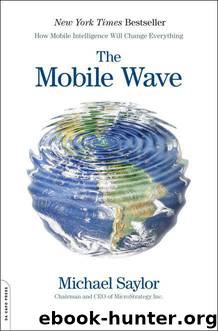The Mobile Wave: How Mobile Intelligence Will Change Everything by Michael Saylor

Author:Michael Saylor [Saylor, Michael]
Language: eng
Format: mobi
ISBN: 9780306822988
Publisher: Vanguard Press
Published: 2013-05-27T14:00:00+00:00
The medical record is a creature of accretion. In the early nineteenth century, most physicians were rural general practitioners (GP). For instance, George Huntington, who published the classic description of Huntington’s chorea in 1872, was an obscure, music-loving doctor in New York State. He and other practitioners kept medical records as simple personal files, often covering a patient’s entire lifetime. As knowledge expanded in the late nineteenth century, specialties arose. By 1930, one quarter of physicians were specialists, and about two-thirds are today.5 Because a patient now sees more than one doctor, far more professionals have to read each record and add to it. In addition, medical technology has made tremendous strides, and there is a great deal more information available for each patient. So the files have grown.
Thus, today’s medical record contains information on vital signs, medications, prescriptions, allergies, referrals, lab results (including X-rays), insurance records, payment accounts, and more. It has a covey of authors, is largely handwritten, and serves medical, legal, administrative, and billing purposes, as well as acting as an archive for future research and the teaching of medical students. For outpatient visits, a physician can spend up to 38 percent of his time locating information and writing observations.6 As one medical director at a major hospital said, “The charts are so thick with everyone documenting, documenting, documenting, you can’t make your way through them.”7
Ultimately, everyone pays.
Electronic medical records have been available for years, but they’ve faced varied forms of resistance. Doctors liked paper because they could jot notes while looking directly at the patient; computer use disrupts eye contact. Electronic records have been costly. The software itself has often been complicated and difficult to learn. Even so, if the U.S. medical world had gone electronic in the late ’90s, by one estimate we could have saved thousands of lives and billions of dollars.8 With everyone connected, doctors could easily access information twenty-four hours a day. They would rarely repeat tests, because the results would be available to all, and emergency responders could know an injured person’s entire medical history before even reaching him. Centralized information isn’t foolproof, but it’s simpler, faster, more accessible, and ultimately less expensive.
The Obama administration required doctors and hospitals to go digital by 2014 or—if they’re in the Medicare system—face penalties starting the following year. The 2009 stimulus bill pumped billions of dollars in incentives into this effort, while the 2010 health care law set up more programs to encourage the use and study of digital dossiers. With electronic records on file, the medical system will be poised to utilize mobile technology, a move that will further enhance the medical chart system in many ways.
For instance, the handwritten chart will become obsolete, and electronic records on a desktop computer already can replace it. One study found that the amount of time it takes an employee to pull and replace a chart costs $5, and since electronic records reduced chart pulls by 600 per year per physician, those alone could save $3,000 per physician.
Download
This site does not store any files on its server. We only index and link to content provided by other sites. Please contact the content providers to delete copyright contents if any and email us, we'll remove relevant links or contents immediately.
| Automotive | Engineering |
| Transportation |
Whiskies Galore by Ian Buxton(41711)
Introduction to Aircraft Design (Cambridge Aerospace Series) by John P. Fielding(33011)
Small Unmanned Fixed-wing Aircraft Design by Andrew J. Keane Andras Sobester James P. Scanlan & András Sóbester & James P. Scanlan(32678)
Craft Beer for the Homebrewer by Michael Agnew(18074)
Turbulence by E. J. Noyes(7888)
The Complete Stick Figure Physics Tutorials by Allen Sarah(7258)
Kaplan MCAT General Chemistry Review by Kaplan(6812)
The Thirst by Nesbo Jo(6748)
Bad Blood by John Carreyrou(6468)
Modelling of Convective Heat and Mass Transfer in Rotating Flows by Igor V. Shevchuk(6349)
Learning SQL by Alan Beaulieu(6152)
Weapons of Math Destruction by Cathy O'Neil(6075)
Man-made Catastrophes and Risk Information Concealment by Dmitry Chernov & Didier Sornette(5870)
Digital Minimalism by Cal Newport;(5576)
Life 3.0: Being Human in the Age of Artificial Intelligence by Tegmark Max(5396)
iGen by Jean M. Twenge(5294)
Secrets of Antigravity Propulsion: Tesla, UFOs, and Classified Aerospace Technology by Ph.D. Paul A. Laviolette(5232)
Design of Trajectory Optimization Approach for Space Maneuver Vehicle Skip Entry Problems by Runqi Chai & Al Savvaris & Antonios Tsourdos & Senchun Chai(4949)
Electronic Devices & Circuits by Jacob Millman & Christos C. Halkias(4859)
